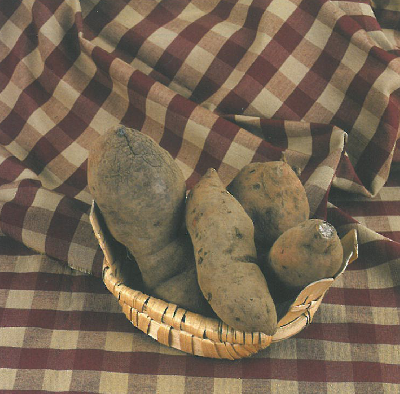Description: Batata doce de Aljezur PGI (Aljezur sweet potato) is the adventitious, fleshy, tuberous root of the plant Ipomoea batatas (L.) (syn. Batatas edulis) of the Lira variety and Convolvulaceae family. Elongated and pear shaped, its skin is purple or reddish brown and its flesh yellow. Its size varies between 8,5x4,0 cm and 16,5×7,1 cm and it reaches a weight of between 50 and 450 g. It has a sweet taste and its texture is not very fibrous. When eaten raw its taste is similar to that of chestnuts.
Production method: The nursery area is set up in February when roots are planted 10-15 cm deep in the ground, each one in an area 50×60 cm. In April/May takes place the move to the final growing area when a piece of the stem measuring 25 cm in length is planted. Each one is planted in an area 20×65 cm. The plant remains in the ground for about four months. Most of the harvesting is done in October, when the roots have reached maturity and there is not too much moisture in the soil. After harvesting, the sweet potatoes are dried above ground for around eight days, to allow suberisation and so that any cuts can heal. The sweet potatoes are then washed to remove excess soil and other impurities. The sweet potatoes are stored in a cool, ventilated area with an average temperature of 13/14 °C.
Distinctive features: It has a sweet taste and its texture is not very fibrous. When eaten raw its taste is similar to that of chestnuts.
Production area: The geographical area of production, preparation and packaging is restricted to the municipality of Aljezur in the Faro district and to the parishes of São Teotóneo, São Salvador, Zambujeira do Mar, Longueira-Almograve and Vila Nova de Milfontes of the Odemira municipality in the district of Beja.
History: The town of Aljezur was founded in the tenth century by Arabs and later seized from the Moors in 1249. According to legend (although this clashes with history and the date of the sweet potato's introduction into Europe), the Knights of the Order of St James of the Sword, led by Paio Peres Correia, drank a potion made from sweet potato before every important battle. The force of the invasion and the speed with which they took the castle of Aljezur stunned the Moors, who were unable to react to such a sudden charge. The conquest took place in 1249 and, according to the legend, the potion that was the determining factor in the victory was none other than the famous ‘feijoada de batata doce de Aljezur’ (the Aljezur sweet-potato bean stew). Whatever the truth of this story, the sweet potato's origins in Aljezur have been lost over time, which serves to illustrate that it has a long tradition in the region and in the diet of the local people. The root vegetable is perfectly adapted to the natural conditions of the area in question, it is closely linked to local tradition, while its origins have been lost over time. It is still eaten today because consumers of this type of product recognise that these sweet potatoes have unique characteristics (sweet, smooth and not particularly fibrous) and prefer sweet potatoes of the Lira variety produced in this region to those imported from other parts of the world.
Product specification (pdf)
Producer group
Associação dos Produtores de Batata doce de Aljezur
Control and certification body
Kiwa Sativa – Unipessoal, Lda.
Control plan
Control plan (pdf)
Publication in EU official journal
Regulamento (CE) n.º 510/2006 do Conselho de 19.12.2008 (2008/C 324/13)
Regulamento (CE) n.º 752/2009 da Comissão de 17 de Agosto de 2009



